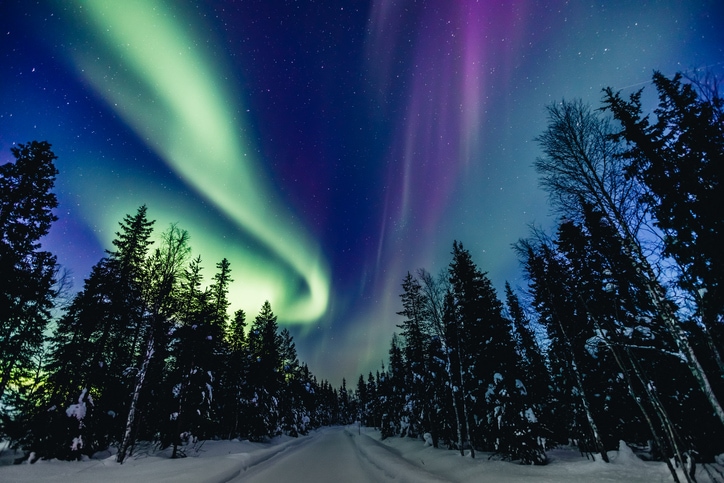How Do Aurora Borealis Affect Technology on Earth?
At VALO Finland, we are passionate about sharing the wonders of Lapland with our guests. One of the most awe-inspiring natural phenomena you can witness here is the aurora borealis, or northern lights. While these dazzling displays of light captivate onlookers, they also have significant effects on technology on Earth. In this blog post, we will delve into how the aurora borealis impacts various technological systems and what measures are being taken to mitigate these effects.
Understanding the Aurora Borealis
The aurora borealis, commonly known as the northern lights, is a natural light display predominantly seen in high-latitude regions around the Arctic and Antarctic. This phenomenon occurs when charged particles from the sun, known as solar wind, interact with the Earth’s magnetic field and atmosphere. These interactions excite atmospheric gases, causing them to emit light in various colours, primarily green and pink.
While the aurora borealis is a visual spectacle, it is also a manifestation of space weather. Space weather refers to the environmental conditions in space as influenced by the sun and the solar wind. The same solar activity that creates the auroras can also lead to geomagnetic storms, which have the potential to disrupt various technological systems on Earth.
How Geomagnetic Storms Disrupt Technology
Geomagnetic storms are disturbances in the Earth’s magnetosphere caused by solar wind and solar flares. These storms can induce electric currents in the Earth’s surface and atmosphere, leading to a range of technological disruptions. The intensity of these storms can vary, with more severe storms having a greater impact on technology.
One of the primary ways geomagnetic storms affect technology is through the induction of geomagnetically induced currents (GICs). These currents can flow through power lines, pipelines, and other conductive structures, potentially causing damage and operational issues. Additionally, geomagnetic storms can interfere with radio communications, GPS signals, and satellite operations, leading to widespread disruptions.
Impact on Power Grids and Pipelines
Power grids are particularly vulnerable to the effects of geomagnetic storms. The induced currents can overload transformers and other critical components, leading to voltage instability, equipment damage, and even large-scale blackouts. For instance, the 1989 geomagnetic storm caused a major blackout in Quebec, Canada, leaving millions without power for several hours.
Pipelines are also susceptible to geomagnetically induced currents. These currents can accelerate the corrosion of pipelines, reducing their lifespan and increasing the risk of leaks and failures. Monitoring and mitigating these effects is crucial for maintaining the integrity and safety of pipeline infrastructure.
Satellite Communication and Navigation
Satellites play a vital role in modern communication and navigation systems. However, geomagnetic storms can disrupt satellite operations in several ways. The increased radiation levels during a storm can damage satellite electronics, degrade solar panels, and interfere with onboard sensors. This can lead to temporary or permanent loss of satellite functionality.
Additionally, geomagnetic storms can cause fluctuations in the Earth’s ionosphere, affecting the propagation of radio signals used for communication and navigation. GPS signals, in particular, can become less accurate or completely unavailable during severe storms, impacting everything from aviation to personal navigation devices.
Preventative Measures and Future Research
To mitigate the impact of geomagnetic storms on technology, various preventative measures are being implemented. Power grid operators are investing in more robust infrastructure, including transformers that can withstand higher levels of induced currents. Real-time monitoring systems are also being developed to provide early warnings of geomagnetic activity, allowing operators to take protective actions.
In the realm of satellite operations, engineers are designing more radiation-hardened components and developing strategies to protect satellites during periods of intense solar activity. Research into improving the accuracy of space weather forecasts is ongoing, with the goal of providing better predictions and more effective mitigation strategies.
At VALO Finland, we are committed to providing our guests with an unforgettable experience in Lapland, where you can witness the breathtaking beauty of the aurora borealis. Our luxury villas offer the perfect vantage point to enjoy this natural wonder, while our expert guides can help you make the most of your stay. Whether you’re interested in learning more about the science behind the northern lights or simply want to relax and take in the view, we are here to ensure your visit is both enlightening and enjoyable.
In conclusion, while the aurora borealis is a stunning natural phenomenon, it also has significant implications for technology on Earth. Understanding these effects and taking appropriate measures to mitigate them is essential for maintaining the reliability and safety of our technological systems. As you plan your trip to Lapland, remember that VALO Finland is here to help you experience the magic of the northern lights in comfort and style.
